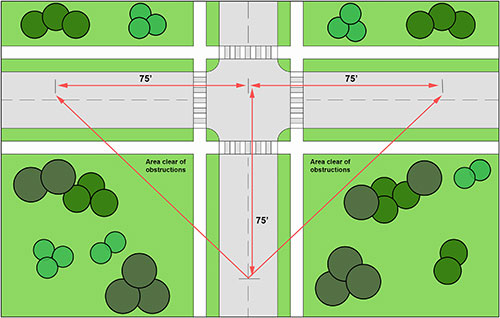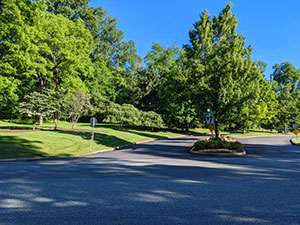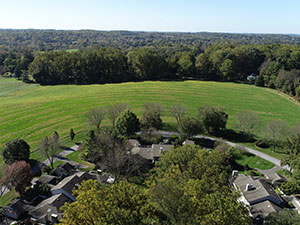Design Elements — Screening
Municipalities may choose to require enhanced screening from adjacent uses or roadways, particularly in rural locations where a denser development may seem out of character with the surrounding landscape patterns. Screening is accomplished much more efficiently if existing vegetation is preserved. The setbacks and required buffer yards from the tract perimeters should not be so onerous that they unnecessarily consume a high percentage of the required open space.
Ordinance Considerations
Setbacks and screening standards for conservation subdivisions should be the similar to those required for conventional subdivisions with comparable densities and housing types. That is, the uses proposed in the subdivision, whether single-family homes, twins, or townhouses, should be the controlling factor, not whether it is a conservation or conventional subdivision. While screening and buffering for privacy is desirable, the goal should not be total invisibility between uses of a similar nature.
Sample Ordinance Language
Section : Screening
The following standards are hereby established to create an acceptable transition between different types and intensities of land uses and to reduce conflicts between those uses.
Applicability
Buffer yards and visual screening, consisting of the indicated Class A, B, C or D buffer, shall be required between the following uses, whether the use is proposed or existing.
- Class A buffer — A Class A buffer shall be required between any development consisting of multi-family dwelling units, single-family attached dwelling units (townhouses), or any portion of a residential development with a net density of four (4) or more units per acre adjoining any residentially zoned district, or residential use.
- Class B buffer — A Class B buffer shall be required between any commercial use, office use, active recreational use, or mobile home park adjoining any residentially zoned district or residential use.
- Class C buffer — A Class C buffer shall be required between any industrial use or intensive agricultural use, except as other wise required in a Class D Buffer, adjoining any residentially zoned district or residential use.
- Class D buffer — A Class D buffer shall be required between the following uses and any other use: junkyard; recycling center; mini-warehouse or similar uses. The buffer shall be provided between the right-of-way line and along all property lines.
- Where residential developments propose streets with reverse frontage lots, the following buffer requirements shall be met along the rear yard lot line:
- Where the rear lot line abuts a street with a functional classification of collector or primary distributor streets, a Class A buffer shall be provided.
- Where the rear lot line abuts a street with a functional classification of principal or minor arterial or abuts an expressway, a Class B buffer shall be provided.
- Other uses determined to be potentially conflicting shall provide the buffer class specified by the governing body upon recommendation by the planning commission.
- Buffer requirements for uses on adjoining village lots may be modified upon recommendation of the planning commission when such modification would be in keeping with the mixed-use character and smaller lot sizes of the particular village. Buffer requirements shall be met along lot lines between village districts and adjacent non-village zoning districts.
*Note: It is recommended that municipalities include a preferred plant list and encourage the use of native species.
Buffer Class Standards
After determining the required buffer class, the applicant shall select an appropriate planting option listed in Figure 3-2. Plantings are not required to be aligned on property or right-of-way boundaries. Rather, the applicant is encouraged to site plantings within the required buffer yard as necessary to achieve the optimal screening level and to blend into the surrounding landscape. Plant materials shall be selected from the plant materials list* in Appendix . No more than thirty (30) percent of a required buffer may consist of one type of plant species.
Figure 3-2
Buffer Class Minimum Buffer Yard Width Minimum Planting Requirements Class A Twenty-five (25) feet One (1) canopy tree per forty (40) feet, plus one (1) evergreen per thirty (30) feet of boundary; or One (1) canopy tree per forty (40) feet, plus one (1) flowering tree per sixty (60) feet, plus one (1) evergreen per sixty (60) feet of boundary. Class B Thirty-five (35) feet One (1) evergreen per fifteen (15) feet, and one (1) flowering tree per fifty (50) feet of boundary. Class C Forty (40) feet One (1) evergreen per twenty (20) feet, plus one (1) berm four (4) feet high; or Six (6) foot high cedar or spruce fencing with one (1) flower or evergreen tree every thirty (30) feet. Class D Thirty (30) feet The following planting shall be provided between the required fence and the street or property line:1 One (1) canopy or flowering tree at an average of one (1) tree per forty (40) feet, plus one (1) evergreen tree at an average of one (1) tree per twenty (20) feet; or One (1) canopy or flowering tree at an average of one (1) tree per forty (40) feet, plus one (1) shrub per eight (8) feet.
Buffer Class Standards
- Existing plantings, woodlands, hedgerows, topography, or man-made structures can reduce or eliminate the buffering requirements if they partially or completely achieve the same level of screening as the planting requirements outlined in this section. This determination shall be made at the discretion of the governing body, upon recommendation by the planning commission.
- With the exception of invasive species, existing trees within the required buffer yard greater than three (3) inches in caliper or greater than eight (8) feet in height shall be preserved to the extent feasible. Such trees may be counted towards required plant materials, as determined by the governing body, upon recommendation by the planning commission.
- Each planting option listed in Subsection B, above, may use any of the plant materials listed in Appendix Minimum plant size shall be as indicated in Appendix .
- The use of native plant species is strongly encouraged, and no invasive species shall be used. In addition, invasive plant species shall not be used in buffer plantings or for any other proposed landscaping.
- All planting materials shall meet the specifications set forth in the American Standards for Nursery Stock.
- The municipality may request, upon recommendation of a registered landscape architect, additional buffer plantings if it is determined that, due to specific site conditions, the prescribed buffer is not fully effective.
- Optional: Where it is determined that, due to topography or other factors, the buffer classes and standards prescribed above do not alone provide an adequate buffer between adjoining incompatible uses, the municipality may require the planting to be placed upon a berm* at a height of three (3) to five (5) feet to increase its effectiveness.
*Note: The use of berms is generally discouraged, particularly in rural areas where it may not blend well with the surrounding landscape.
General Buffering Standards
- All landscaped areas, including buffers, shall be maintained and kept clean of all debris, rubbish, and weeds.
- Planting in the buffer area shall be installed and thereafter maintained by the property owner. Required buffer plantings shall not be removed without the prior approval of the municipality. If such plantings are removed, the municipality may require that they be replaced, in kind, at the expense of the property owner.
- Plant materials required within the buffer area shall be assured by a performance guarantee posted with the municipality in an amount equal to the estimated cost of the plant materials. Buffer plantings shall be guaranteed and maintained in a healthy and/or sound condition for at least eighteen (18) months or shall be replaced. The costs of the landscape material and installation shall be considered in determining the amount of any performance guarantee required.
- The locations, dimensions, and spacing of required plantings shall be adequate for their proper growth and maintenance, considering sizes of such plantings at maturity and their present and future environmental requirements, such as soil, pH, moisture, and sunlight. The buffer planting shall be so placed that, at maturity, vegetation extends not closer than three (3) feet from any street right-of-way.
 A clear sight triangle, in accordance with Section of the ordinance, shall be maintained at all street intersections and at all points where private accessways intersect public streets.
A clear sight triangle, in accordance with Section of the ordinance, shall be maintained at all street intersections and at all points where private accessways intersect public streets.- No structures may be placed within the buffer area and no manufacturing or processing activity or storage of materials shall be permitted, except for the following:
- Landscaped treatments, such as berms, fences or walls which aid in screening and do not conflict with the character of adjoining properties, including drainage, light, and air flow, or block clear sight triangle required at intersections.
- Structures relating to and used for landscaping, such as tree wells, tree guards, tree grates and retaining walls to preserve stands or specimens of existing trees or used for other functional purposes.
- Roads which provide direct ingress/egress for the tract or lot, including appurtenant structures within road rights-of-way, such as curbs, sidewalks, signs, lighting or benches.
- Underground utilities.
- Mechanical equipment, storage structures, loading docks, and similar facilities shall be fully screened from view from adjacent streets or residential zoning districts or uses, through the use of fences or planting materials.
 The applicant is encouraged to install buffer plantings in naturalistic groupings rather than in linear strips, if a satisfactory buffer can be achieved.
The applicant is encouraged to install buffer plantings in naturalistic groupings rather than in linear strips, if a satisfactory buffer can be achieved.- Where buffering is required, a landscape plan shall be submitted consistent with the requirements of Section of this ordinance.
- Where earthen works are required to provide effective screening, the specified elevation of the berm shall be that achieved after the earth has settled.




